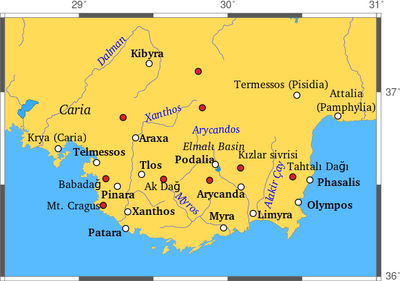Arycanda
| Author: Laxman Burdak, IFS (R). |

Arycanda or Arykanda is an Ancient Lycian city in Antalya Province in the Mediterranean Region of Turkey. Arycandos River flows through it.
Location
Arykanda was built upon five large terraces ascending a mountain slope, located near the small village of Aykiriçay, presently on the Elmalı-Finike road.
Variants of name
- Arykawanda
- Arukanda (Greek)
- Aykiriça
- Arycandus River
- Arukandos
- Karasu Çay (Turkish)
- Karasu (Turkish)
Origin of name
Aryak (आर्यक) Jat gotra gets its name from Nagavanshi ruler named Aryaka (आर्यक).[1] Aryaka may have probably given name to this city and the River.
History
Arycanda is known to be one of the old Lycian cities, as its name ends with -anda, indicative of its Anatolian origin; dating back as far as the 2nd millennium BC.[2]
On the other hand, the oldest remains and finds from the city date from the 6th or 5th century BCE. The site is being excavated and restored by an Ankara University team[3] headed by Prof. Dr. Cevdet Bayburtluoglu[4] since 1971.
Arycanda survived through Byzantine times, until the 6th century when the settlement moved to a new site south of the modern road, which is called Arif (or Aruf) Settlement in archaeological literature so that it will not mix up with the older site.
Acropolis houses Hellenistic and older remains of the site which include the temple of Helios, bouleterion, prytaneion, upper agora withs its shops, and several excavated houses. The lower city houses most of the Roman remains. These include:
A bath complex on the lowest terrace, still virtually intact in its sequence of arches, next to the gymnasium. The city has 7 different bath houses of various sizes.
Lower Agora, some of the shops in its eastern part can still be seen. It is wide and flat, located to the south of the odeon and was enclosed on three sides by a portico. At its middle are the remains of Tyche Temple.
A theatre, in excellent condition, built during the 1st century BCE. It has 20 rows of seats, divided into 7 sections. At the edge of every row are holes that were used to support protective awnings.
Odeon - 2nd century AD. The main entrance is to the south, though a triple portal. This was once a very ornate building, the interior was lined with orthostats and the walls, orchestra and seats were once covered with coloured marble. A block that was discovered (and now housed in Antalya Archaeological Museum) during the excavations over the portal bears a portrait of the Emperor Hadrian.
A stadium, from the Hellenistic period, that resides above the theatre, in the form of a running track with seats built only on one side. It is smaller than a usual stadium, measuring 106 m. long and 17 m. wide.
Two necropoleis. The one on the entrance to the site is very interesting with its series of richly decorated funerary monuments. The eastern necropolis has barrel-vaulted monumental tombs, temple-tombs and sarcophagi and the western necropolis has rock-cut tombs and barrel-vaulted tombs.
References
- ↑ Dr Mahendra Singh Arya etc: Ādhunik Jat Itihas, Agra 1998.
- ↑ Whiting, Dominic (2000-04-01). Turkey Handbook: The Travel Guide. Footprint Handbooks. p. 365. ISBN 1-900949-85-7.
- ↑ Whiting, Dominic (2000-04-01). Turkey Handbook: The Travel Guide. Footprint Handbooks. p. 365. ISBN 1-900949-85-7.
- ↑ Harrison, Martin (2001-09-05). Mountain and Plain: From the Lycian Coast to the Phrygian Plateau in the Late Roman and Early Byzantine Period. p39. University of Michigan Press. ISBN 0-472-11084-5.
Back to Jat Places in Turkey

